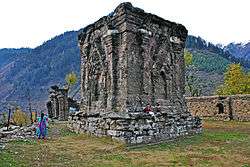Tilla Jogian
| Tilla Jogian Hindu temple complex | |
|---|---|
|
1st-century BC Tilla Jogian Hindu temple complex | |
 Tilla Jogian Hindu temple complex Hindu temple at Tilla Jogian | |
| Geography | |
| Coordinates | 33°23′59″N 73°17′59″E / 33.3997°N 73.2997°ECoordinates: 33°23′59″N 73°17′59″E / 33.3997°N 73.2997°E |
| Country | Pakistan |
| State | Punjab |
| District | Mandi Bahauddin District, Gujrat District, Jhelum District and Chakwal District |
| Location | Salt Range |
| Culture | |
| Primary deity | Shiva, Surya |

Tilla Jogian (in Punjabi ٹلہ جوگیاںUrdu: ٹلہ جوگیاں), location of Tilla Jogian temple complex - a 1st-century BC[1] Hindu and Sikh holy site, is the highest peak in the eastern Salt Range in Punjab, Pakistan.
Location
At 975 meters (3200 ft) above sea level, Tilla Jogian is about 25 km to the west of Jhelum city and 10 km west of the model village of Khukha. The view from the top of Tilla is highly rewarding. Rohtas, Pakistan Fort is located to the east of Tilla Jogian at a distance of about 7 km from Dina, a rapidly expanding town on the Grand Trunk Road.
Tilla Jogian mountain peak can be seen from districts of Mandi Bahauddin, Gujrat, Jhelum and Chakwal. It is situated on a commanding place near the Jhelum River. From its height of 3200 feet, you can see a panorama unparalleled in Pakistan.
Tilla Jogian temple complex
Tilla Jogian temple complex has been place of Hindu pilgrimage for at least 2000 years. It was established in 1st century BC by the Guru Gorakhnath of kanphata Jogis.[1] Tilla Jogian in Punjabi means the Hill of Saints. This is where the Kanphata Jogis, who pierced their earlobes and were an order founded by Guru Gorakhnath have left behind a monastery.[2]
Tilla Jogian comprises a complex of Hindu mandirs housing at least three baths and a network of waterworks with at least two minor dams. There are number of ways to reach at the top: One from Rohtas Fort side and the other from Sanghoi, the Jhelum River side.
Murad Baksh, aka Ranjha, the hero of the real life romantic epic story Heer Ranjha came to this place to join the Jogi order. Guru Nanak (1469-1539 CE), founder of Sikh religion, also meditated here for 40 days. Akbar (1542 - 1605 CE), Mughal Emperor visited this place twice in four years to pay homage and built a water tank here.[1] Jahangir (1605 - 1627 CE), Mughal Emperor also paid a visit here. Ahmad Shah Abdali sacked and looted the monastery.[1] Maharaja Ranjit Singh (1780 - 1839 CE), visited to pay his respect and constructed a big water pond, which still survives in good condition, he also built a monument on the spot where Guru Nanak had meditated for 40 days, which has been vandalized, by making small opening in its north wall and a bit of the domed roof broken, but by late 2005 the damage had been enlarged and the floor uprooted. The British made a road and a pond here for water. The Hindu temple complex and matha (Hindu monastery) lies in ruins.[1]
Vandalism and destruction
The The Express Tribune, the prominent newspaper of Pakistan, reported that this 2100-year-old temple complex is gradually but systematically being desecrated and demolished. Two dozen samadhis (Hindu shrines) that existed in 1994 near Akbar's tank were systematically being demolished in response to the demolition of Babri Masjid by Hindu extremists in India in 1992. In the late 1990s, the floors of two temples were uprooted by the locals to dig the valuables and ancient coins. Government of Punjab, Pakistan, Government of Pakistan, Ministry of Culture (Pakistan) (Department of Archaeology) and Evacuee Trust Property Board have done nothing to protect and restore this 2100-year-old ancient heritage of Pakistan despite complaints by the news reporter.[1]
Mention in literature
Tilla Jogian also finds mention in the epic love poem Heer Ranjha of Waris Shah. Ranjha, the story's protagonist, who when spending his time on the rebound, sublimating his love and passion in the spiritual world, came here for consolation and got his ears ringed here as was the tradition of Guru Goraknath's followers.[3]
Prime Minister Nawaz Sharif visited Tilla Jogian and did some protective work for the safety of its pristine beauty.

External links
- Trekking on the Tilla Jogian by Shaikh Muhammad Ali
- Tilla Jogian picture travelogue
- Tilla Jogian destruction of 1st century BC heritage of Pakistan
See also
References
- 1 2 3 4 5 6 Tilla Jogian Hindu heritage
- ↑ Gorakhnāth and the Kānphaṭa Yogīs, George Weston Briggs, Motilal Banarsidass Publishers, 1938, ISBN 9788120805644, ... The Kanphatas possess many monasteries ... but that at Tilla, in the Panjab, is generally considered to be the chief seat of the Gorkhnathis ...
- ↑ The social space of language: vernacular culture in British colonial Punjab, Farina Mir, University of California Press, 2010, ISBN 9780520262690, ... A fourth locale, Tilla Jogian, is the location of Gorakhnath's dera (monastery) and the site of Ranjha's transformation into a yogi ...



